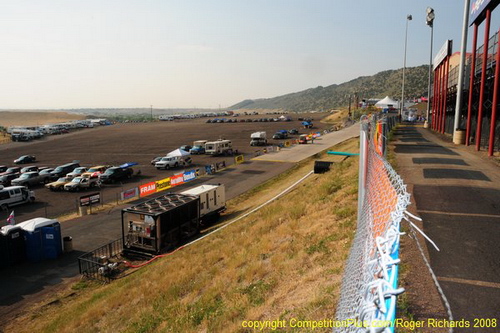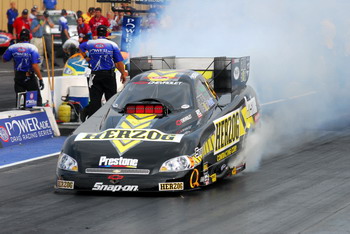DENVER STARTING LINE DRAWS PRAISE
Sun, 2008-07-13 12:29

The chiller unit is located on the backside of the grandstands. This
unit keeps the starting line at Bandimere Speedway a consistent
temperature, which means the world to many of the racers. (Roger Richards Photos)
Bandimere Speedway’s innovative underground cooling system needed only one professional qualifying sessions to feel the love from the drag racers.
Racers in both the sportsman and professional ranks are singing the praises of the new inner cooled race track which, in the midst of 90-degree ambient air temperatures, measured 101 degrees on the starting line and 120 within 100 feet of the starting line. Last year the starting line track temperature hovered in the 140-degree range.

The chiller unit is located on the backside of the grandstands. This
unit keeps the starting line at Bandimere Speedway a consistent
temperature, which means the world to many of the racers. (Roger Richards Photos)
Bandimere Speedway’s innovative underground cooling system needed only one professional qualifying sessions to feel the love from the drag racers.
Racers in both the sportsman and professional ranks are singing the praises of the new inner cooled race track which, in the midst of 90-degree ambient air temperatures, measured 101 degrees on the starting line and 120 within 100 feet of the starting line. Last year the starting line track temperature hovered in the 140-degree range.
Bandimere Speedway calls their system simply “track cooling system” and transpired as a joint venture between facility manager Larry Crisp and P.J. Harvey with VHT and PJ brands. The idea came forth when the two were discussing methods of cooling the track to work better with the traction compound.
“You know we just want to put on a good show, we want side by side racing,” said Jeff Sipes, director of Marketing Media & Special Events for Bandimere. “We’ve been brainstorming for years, if we could cool that track somehow. So what we did was we resurfaced our track, we went concrete from half track through the finish line.

“We can manipulate the power just past 100 feet and the first 150 feet
are crucial to us. We’d love for other track operators
to look at what they’ve done here. If you can get a car up and running
in that first 150 feet then you have a tremendous head start on the
run. It has been talked about a lot but it was Bandimere who stepped up
to the plate and made it happen first.” - Tony Pedregon
Sipes said the cooling lines are 480-feet in length and each lane carries 17 lines. The track has two storage tanks buried on the east side of the track, with each holding close to 12,000 gallons of water.
“We’ve probably got about 25,000 gallons of water right now in the system,” Sipes admitted. “Father’s Day weekend we ran our Lucas Oil Drag Racing series event, we just had ground temperature water that had just been taken out of the fire hydrant. We had water temperature that started at about 65 degrees and on Friday that night we ran our alcohol cars. The area that is cooled we had a track temperature of 105 and down track it was 120. So we knew that it was working well.”
Sipes added those temperatures represented the surface temperature.
“We’ve also got in-track probes that help us measure that,” Sipes added. “But our problem was extracting the heat from the water overnight. We really weren’t very efficient at that, so we’ve since added a chiller. We’ve got a chiller installed just on the east side of our grandstands behind the fans. With that chiller we can get water down to 40 degrees if we absolutely needed to.”
The goal is to enable the high horsepower cars to get a running start at the transition where the water cooling unit ends. The wheel speed is crucial towards ensuring the car makes it to the finish line under power.
The value in this program might not be immediately noticeable to the race fans in the stands, but to the crew chiefs, the value is quickly noticed in the tune-up.
The week before the NHRA Mopar Mile High Nationals a large contingent of 500-inch Pro Stocker tested the racing surface without the cooling mechanism in place and deemed the surface a winner already. The cooling unit only enhances what they say was already good to begin with.
“It seems to me like this track is incredibly consistent at this point in time, much more than in the past, much more than last week because the cooling system wasn’t on because they were working,” veteran local Pro Stock driver Gaines said. “Just from a visual point of view, I think it might be the best thing to come along in a while especially for summer drag racing.”
Nitro Funny Car champion Tony Pedregon drove his way to the provisional top spot on Friday. He has nothing but praise for Bandimere in what he admits is setting the standard for all drag strips with this cooling system.
“We can manipulate the power just past 100 feet and the first 150 feet are crucial to us,” Pedregon said. “We’d love for other track operators to look at what they’ve done here. If you can get a car up and running in that first 150 feet then you have a tremendous head start on the run. It has been talked about a lot but it was Bandimere who stepped up to the plate and made it happen first.”
The transition from cool to normal temperature is one that Gaines said offered no difference. He admitted it was a seamless transition.
NHRA Fuel Racing liaison Dan Olson admitted the cooling system has made the track preparation process for hotter weather conditions much easier.
“It works extremely well,” said Olson. “We are seeing some things like we’ve never seen before like the rubber buildup. It’s not causing issues. There is no problem with it.”
During the summer months, extreme track temperatures can make tuning a race car a challenge. Sipes hopes this program will eliminate some of the guesswork from finding a combination on a fluctuating track temperature.
“Our goal is to have a consistent track,” Sipes said. “We can adjust the chiller, I’m not sure we are able to fine tune it yet because it’s so new to us we can’t fine tune to make sure it’s the exact same temperature every time. Our goal is to just get it cooler. If it is 70 degrees outside with cloud cover and the track temp is 80 we don’t really need to be doing anything. But if we can get it down from 140 to 120 then we can have better success getting cars down the track.
“It’s going to be one of those deals where as we learn the system and have more experience using it then we can try and get the track temps more consistent so it’s less of a variable for the crew chiefs as well.”
Categories:




































